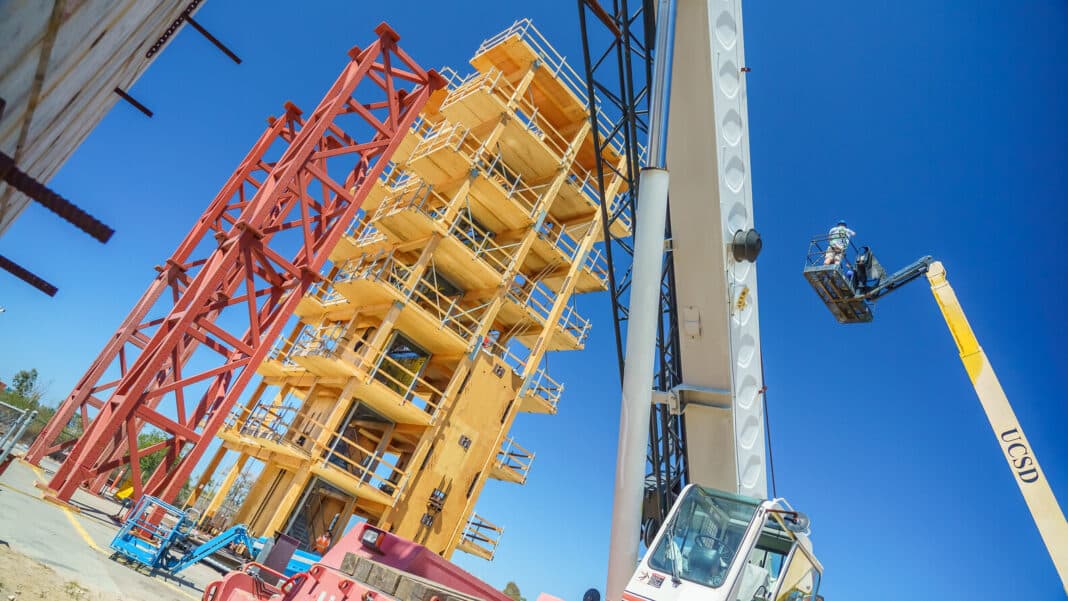A 10-storey cross-laminated timber building has been tested for the 100th time on one of the world’s two largest earthquake simulators at the University of California San Diego.
Previously reported by Science Blog, the experiment, known as the TallWood Project, is the tallest full-scale building ever to undergo testing on an earthquake simulator or shake table.
The mock-up has already been subjected to more than 100 seismic events during the $3.7 million experiment and will undergo more before the testing period ends in August.
“You’re putting a building through the number of quakes it will never, ever experience unless it’s around for 5000 years,” says Thomas Robinson, founding principal of Lever Architecture. This Portland, Oregon, firm helped design the TallWood structure.
Recent changes to building codes in the US permit mass timber buildings as tall as 18 storeys.
But unknown until now is how such high-rises would fare in earthquake-prone areas of the world such as California.
The structure has survived early tests with experts welcoming ‘good signs’ for future of mass timber buildings
In early May, researchers simulated two of the largest earthquakes in recent decades — the 6.7 magnitude earthquake that struck Northridge, California, in 1994, and the 7.7 Chi-Chi earthquake that struck Taiwan in 1999 and killed more than 2,400 people.
First, they “played” the Northridge earthquake on the simulator for five minutes before turning to the Chi-Chi earthquake, watching the building throughout the process.
“The building moved around just like a tree in a windstorm,” Pei said.
Tallwood endured no structural damage, only the odd chip or crack in the drywall after the Chi-Chi simulation, things “you can repair very easily,” he added.
Introducing ‘the Shake Table’
For nearly 20 years, the university has hosted a critical earthquake research tool: a large metal platform that imitates seismic shifts using hydraulics.
According to Popular Science, the “vibration table,” among the biggest in the world, has examined 30+ structures since 2004, impacting building codes and transport rules.
For the past nine months, the table has stood idle, in preparation for the TallWood Project, the highest ever to be put to a high-magnitude test.
The shake table can recreate earthquake movements of various magnitudes on the Richter scale, ranging from 4 to 8, by mimicking seismic activity from past earthquakes, including the Northridge earthquake that hit Los Angeles in 1994.
To do this, the table was accelerated to at least 1g, causing the building’s top to reach up to 3gs, similar to the acceleration experienced by some roller coasters.
The earthquake simulator can hold structures weighing up to 2,000 metric tonnes, equivalent to approximately 1,300 cars, and is the world’s most substantial payload capacity. It is also the only large-scale earthquake table located outdoors.
The National Science Foundation recently invested $17 million to improve the table, enabling it to replicate 3D ground motions during earthquakes when the ground moves in all six degrees of freedom: longitudinal, lateral, vertical, roll, pitch, and yaw.
The shake table is part of NSF’s Natural Hazards Engineering Research Infrastructure network, which comprises eight experimental facilities dedicated to developing innovative research on mitigating damage caused by natural disasters such as earthquakes, tsunamis, landslides, windstorms, storm surges, and flooding.
“The combination of the largest payload capacity in the world, an outdoor setting, and the newly added six-degrees-of-freedom shaking capability, make the UC San Diego shake table a powerful and unique facility,” said Professor Joel Conte, principal of the department of structural engineering at the UC San Diego Jacobs School of Engineering.
“It’s the only place where the TallWood Project tests could happen,” Conte said.
The TallWood structure was constructed to its actual size, standing at an impressive 10 floors high, reaching around 35.5 mm, approximately one-fifth of Washington, DC’s National Monument’s height.
Besides evaluating the 10-floor mass timber edifice, scientists will also assess various non-structural elements’ performance, such as a triple-level glass exterior.
Unprecedented interest in Mass Timber Construction
According to the university, buildings made of mass timber are gaining popularity as greener and faster alternatives to concrete and steel structures.
With new building codes updated to permit more high-rise mass-timber buildings in the US, there are many questions about how such buildings would fare in earthquakes.
“Mass timber is part of a massive trend in architecture and construction, but the seismic performance of tall buildings made with these new systems is not as well-understood as other existing building systems,” said Shiling Pei, principal investigator and associate professor of civil and environmental engineering at Colorado School of Mines.
Pei’s group, comprising both researchers and practitioners, created a mass timber rocking wall lateral system that is ideal for areas with a high earthquake risk. This system is designed to deliver robust performance, ensuring that the building sustains minimal damage during design-level earthquakes and can be promptly repaired following rare earthquakes.
“The rocking wall system basically consists of a solid wood wall panel anchored to the ground using steel cables or rods with large tension forces in them,” Pei said.
“When exposed to lateral forces, the wood wall panels will rock back and forth – which reduces earthquake impacts – and then the steel rods will pull the building back to plumb once the earthquake passes.”
Due to this seismic movement induced by the rocking system, resilience-critical non-structural components within and covering the building, such as the exterior facade, interior walls and stairways, are in for a big ride.
“Resilient design must also account for the building’s non-structural systems, which are not part of the structural load-resisting system, but play an important role in the building’s function and its ability to recover after the earthquake,” says Keri Ryan, a project co-investigator and engineering professor at the University of Nevada.
The project team led by Ryan prioritised the safety of non-structural components, such as four exterior façade assemblies, select interior walls, and a 10-storey stair tower.
These components were exposed to the relative movement between storeys. The exterior envelope and the stair tower are critical to protect the building from weather, and allow occupants to exit safely.
“These assemblies have been designed with a variety of new and innovative details that are intended to accommodate the floor-to-floor movement without damage,” Ryan said. “Many of these details have never been tested in a rigorous building setting.”
The long-term objective of the project
The ultimate aspiration for the TallWood project is to demonstrate that a large wooden building can withstand earthquakes and perform better than concrete, brick, or steel structures.
After six years of research and planning, the excitement at the shake site was palpable, Pei said.
“It is very rare to have an appointment with an earthquake,” he said.
Even more impressive was climbing to the top of the structure and seeing it “good as new,” Pei said.







